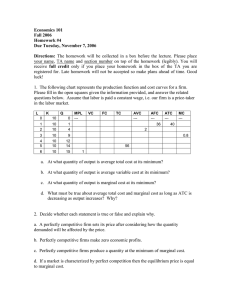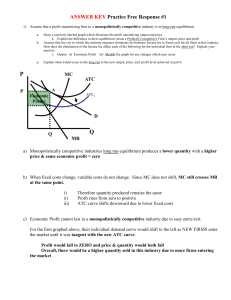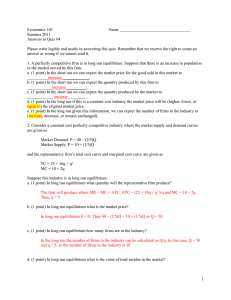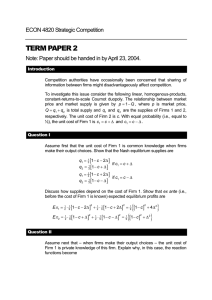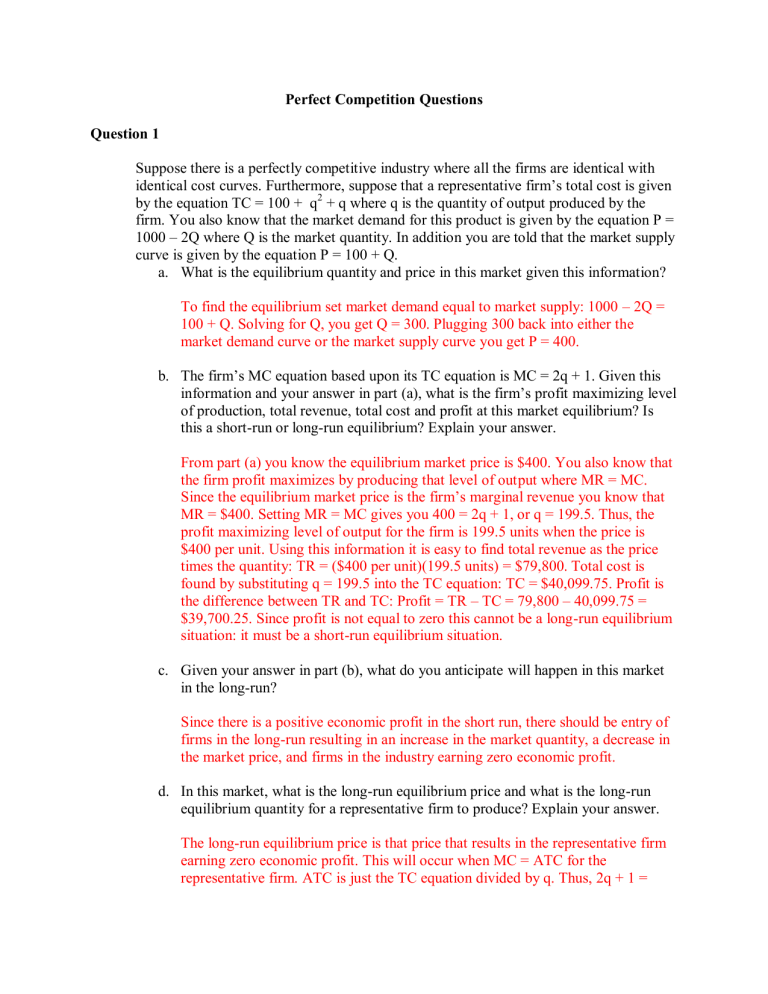
Perfect Competition Questions Question 1 Suppose there is a perfectly competitive industry where all the firms are identical with identical cost curves. Furthermore, suppose that a representative firm’s total cost is given by the equation TC = 100 + q2 + q where q is the quantity of output produced by the firm. You also know that the market demand for this product is given by the equation P = 1000 – 2Q where Q is the market quantity. In addition you are told that the market supply curve is given by the equation P = 100 + Q. a. What is the equilibrium quantity and price in this market given this information? To find the equilibrium set market demand equal to market supply: 1000 – 2Q = 100 + Q. Solving for Q, you get Q = 300. Plugging 300 back into either the market demand curve or the market supply curve you get P = 400. b. The firm’s MC equation based upon its TC equation is MC = 2q + 1. Given this information and your answer in part (a), what is the firm’s profit maximizing level of production, total revenue, total cost and profit at this market equilibrium? Is this a short-run or long-run equilibrium? Explain your answer. From part (a) you know the equilibrium market price is $400. You also know that the firm profit maximizes by producing that level of output where MR = MC. Since the equilibrium market price is the firm’s marginal revenue you know that MR = $400. Setting MR = MC gives you 400 = 2q + 1, or q = 199.5. Thus, the profit maximizing level of output for the firm is 199.5 units when the price is $400 per unit. Using this information it is easy to find total revenue as the price times the quantity: TR = ($400 per unit)(199.5 units) = $79,800. Total cost is found by substituting q = 199.5 into the TC equation: TC = $40,099.75. Profit is the difference between TR and TC: Profit = TR – TC = 79,800 – 40,099.75 = $39,700.25. Since profit is not equal to zero this cannot be a long-run equilibrium situation: it must be a short-run equilibrium situation. c. Given your answer in part (b), what do you anticipate will happen in this market in the long-run? Since there is a positive economic profit in the short run, there should be entry of firms in the long-run resulting in an increase in the market quantity, a decrease in the market price, and firms in the industry earning zero economic profit. d. In this market, what is the long-run equilibrium price and what is the long-run equilibrium quantity for a representative firm to produce? Explain your answer. The long-run equilibrium price is that price that results in the representative firm earning zero economic profit. This will occur when MC = ATC for the representative firm. ATC is just the TC equation divided by q. Thus, 2q + 1 = (100 + q2 + q)/q. Solving for q, q = 10. Plugging 10 in for q into the ATC equation yields the following: ATC = (100 + 102 + 10)/10 = 21. So, when Price equals MR = min ATC = MC = $21, this firm will break even. To see this compute TR for the firm when it produces 10 units and sells each unit for $21: TR = $210. Notice that this is the same as the firm’s TC: thus, the firm earns zero economic profit. e. Given the long-run equilibrium price you calculated in part (d), how many units of this good are produced in this market? To find this quantity you need to substitute $21 (the long-run equilibrium price) into the market demand curve to determine the quantity that the market must produce in order to be in long-run equilibrium. This quantity is equal to 489.5 units. Question 2 The market for study desks is characterized by perfect competition. Firms and consumers are price takers and in the long run there is free entry and exit of firms in this industry. All firms are identical in terms of their technological capabilities. Thus the cost function as given below for a representative firm can be assumed to be the cost function faced by each firm in the industry. The total cost and marginal cost functions for the representative firm are given by the following equations: TC = 2qs2 + 5qs + 50 MC = 4qs + 5 Suppose that the market demand is given by: PD = 1025 - 2QD Note: Q represents market values and q represents firm values. The two are different. a) Determine the equation for average total cost for the firm. ATC for the firm is TC/q, so dividing the total cost equation above by q gives us: ATC = 2qs + 5 + 50/qs b) What is the long-run equilibrium price in this market? (Hint: since the market supply is unknown at this point, it’s better not to think of trying to solve this problem using demand and supply equations. Instead you should think about this problem from the perspective for a firm. Specifically, a long run equilibrium occurs where ATC = MC = Price) In a long-run equilibrium, ATC equals Marginal Cost and profits equal zero. Setting the two equations equal: ATC = 2qs + 5 + 50/qs = 4qs + 5 = MC 50/qs = 2qs 50 = 2qs2 25 = qs2 Take the square root of both sides and find: 5 = qs However, the question wants us to find long run prices. We know that the firm produces were Price = MR = MC, so if we can determine the firm’s MC, then we can determine the equilibrium price in the market. We know that: MC = 4qs + 5 And solved for: 5 = qs Substituting: MC = 4(5) + 5 = 25 The equilibrium price in the market is 25. c) What is the long-run output of each representative firm in this industry? We solve for this in the previous part. 5 = q s d) When this industry is in long-run equilibrium, how many firms are in the industry? (Hint: firms are identically sized). Now we should determine the market quantity Q from the market demand curve, given that we know the market price is 25. Market demand is given as: PD = 1025 - 2QD And we know that market price = 25, so: 25 = 1025 - 2QD 1000 = 2QD 500 = QD Since each firm is making 5 units (as we found in parts b and c), there must be 100 firms, since they are all identically sized. Now suppose that the number of students increases such that the market demand curve for study desks shifts out and is given by, PD = 1525 - 2QD e) In the short-run will a representative firm in this industry earn negative economic profits, positive economic profits, or zero economic profits? (Hint: You can solve this without calculation.) The demand curve has shifted to the right. Given what we learned earlier in the semester, we should know that the market price will increase. If market prices are increasing, then firms are earning higher marginal revenues than they earn in a long-run equilibrium. This means that firms are earning positive economic profits. f) In the long-run will a representative firm in this industry earn negative economic profits, positive economic profits, or zero economic profits? (Hint: again, no calculation required) In the long-run economic profits are always zero since there is free entry/exit in a perfectly competitive market. Firms will either enter the industry until there are no possible profit opportunities. If there are economic losses, firms will leave the industry until profits hit zero. g) What will be the new long-run equilibrium price in this industry? The same as it was before, P = 25, because that is where zero-profits occur for firms. h) At the new long-run equilibrium, what will be the output of each representative firm in the industry? Firm output will still be 5 as this is the quantity where ATC = MC, and long-run profits are zero. i) At the new long-run equilibrium, how many firms will be in the industry? This will be different since there is a new demand curve. Specifically, there is a new market demand. With the new market demand curve: PD = 1525 - 2QD We can substitute P = 25: 25 = 1525 - 2QD 1500 = 2QD 750 = QD We can see that the new market demand is 750. Since each firm produces 5 units and firms are all identical, there must be 750/5 or 150 firms. Now, consider another scenario where technology advancement changes the cost functions of each representative firm. The market demand is still the original one (before the increase in the number of students). The new cost functions are: TC = qs2 + 5qs + 36 MC = 2qs + 5 j) What will be the new equilibrium price? Is it higher or lower than the original equilibrium price? Similar to part b), in a long-run equilibrium, ATC equals Marginal Cost and profits equal zero. Setting the two equations equal: ATC = qs + 5 + 36/qs = 2qs + 5 = MC 36/qs = qs 36 = qs2 Take the square root of both sides and find: 6 = qs However, the question wants us to find long run prices. We know that the firm produces were Price = MR = MC, so if we can determine the firm’s MC, then we can determine the equilibrium price in the market. We know that: MC = 2qs + 5 And solved for: 6 = qs Substituting: MC = 2(6) + 5 = 17 The equilibrium price in the market is 17. The price is lower than before, and this makes sense because the technological improvement has lowered the costs for the firm. With lower costs, the price is lower for firms to have zero profits. k) In the long-run given this technological advance, how many firms will there be in the industry? Now we should determine the market quantity Q from the market demand curve, given that we know the market price is 17. Market demand is given as: PD = 1025 - 2QD And we know that market price = 17, so: 17 = 1025 - 2QD 1008 = 2QD 504 = QD Since each firm is making 6 units (as we found in parts b and c), there must be 84 firms, since they are all identically sized. (504/6 = 84) Since each firm faces lower costs, more firms need to enter the industry to drive down prices so that there are zero profits in the long run. We see the number of firms increase, the price decrease, and the market quantity increase as a result of this competition in the long run. Question 3 (Please put some thought into these) a) Describe the factors that drive profits to zero in perfectly competitive markets in the long run. Explain carefully the incentives that drive the market to a long run equilibrium. The biggest factor driving this is the free entry/exit of firms in the long run, and that firms are selling identical products. With firms being able to enter and exit the market as they wish, profit opportunities cannot last. If I observe another firm making positive profits, there is an incentive for me to enter the industry (at no cost) and try to take advantage of some of these profits. Since there are many identical firms, there will be many firms entering the industry to take advantage of these profit opportunities. However, when many firms compete, the market price decreases and the profit opportunities disappear. b) Why would a firm choose to operate at a loss in the short run? Explain carefully. If the firm can cover their variable costs in the short run, then they can start to pay down some of their fixed costs by producing. If they shut down they must pay all of their fixed costs. If the firm can cover the variable costs they can use any excess revenue towards paying their fixed costs, which is a better outcome than shutting down in the short run. In the long run a firm cannot constantly operate at losses and will eventually leave the industry unless costs change. c) When do firms decide to shut down production in the short run? Explain carefully. If the firm cannot cover their variable costs, then the act of production is going to lead to larger losses than simply shutting down and paying the fixed costs. It doesn’t make sense for a firm to lose more money by staying open than what they would lose if they simply chose not to produce. d) Draw a graph for a perfectly competitive market, specifically showing the short run supply curve. What is the relationship between the short run supply curve and what we talked about in parts (b) and (c)? Explain carefully. The short-run supply curve is the marginal cost curve anywhere above the intersection with average variable costs. Specifically, the firm will only produce goods if the marginal revenue covers their variable costs (even if they operate at a loss). However, when marginal revenue falls below variable costs the firm will shut down in the short run. (Graph omitted, see lecture notes). Question 4 Consider a perfectly competitive market in the short run. Assume that market demand is P 100 4QD and market supply is P=Qs. Denoting firm level quantity by q, assume TC=50+4q+2q2 so that MC=4+4q. a) What is the market equilibrium price and quantity? Set demand equal to supply and find 100-4Q=Q, so Q=20, P=20. b) How many firms are in the industry in the short run? Perfectly competitive firms will set P=MC, so 20=4+4q, so q=4. If each perfectly competitive firm is producing 4, market output is 20, there will be 5 perfectly competitive firms in the industry. c) Do firms make a profit or loss in the short run, and how much are these profits/losses? Firms will make losses in the short run. There are a variety of ways to see this. One is to calculate ATC = 50/q+4+2q, set q=4, and find ATC=24.5, so price is less than ATC, by 4.5, and they are selling 4, so the losses are 18. Another way is to calculate this is to calculate total revenue (P*Q=80) minus total cost 50+16+32=98 and see the difference is -18 (or a loss of 18). d) What is the equilibrium price in the long run? What will be equilibrium profit in the long run? How many firms will there be in the long run? Hint, for the last part of the question, assume that there can be fractional firms, if necessary – if the numbers of firms are in units of 10,000, for example, the answer will be fine. Moreover, assume the entry or exit in the industry will cause the supply curve to shift, while the demand curve does not shift. Therefore, industry output can be found by taking the long-run price and plugging it into the demand curve. There will obviously be exit from the industry if perfectly competitive firms are making losses in the short run. Equilibrium long-run profits will be zero. In the long-run, firms will produce at the minimum of the average total cost curve. That occurs where MC=ATC. Setting these two equal, we have 4+4q=50/q+4+2q. Solving this for q, we get 2q=50/q, or q=5. Each of the remaining firms will be larger (before they produced 4, now they produce 5). The long-run equilibrium price will be equal to marginal cost (or ATC) when MC=ATC. So plug the quantity 5 into MC and find the long-run equilibrium price, P=24. The exit of firms causes the supply curve to shift back (demand will stay constant). So, from the demand curve, the total output consistent with the market price is Q=19 (this comes from 24=100-4Q). If total output in the market is 19 and each firm in the industry produces 5, there will be 3.8 firms in the industry.
